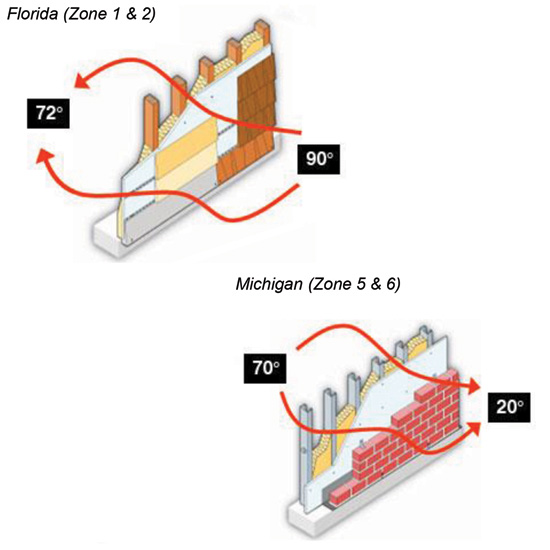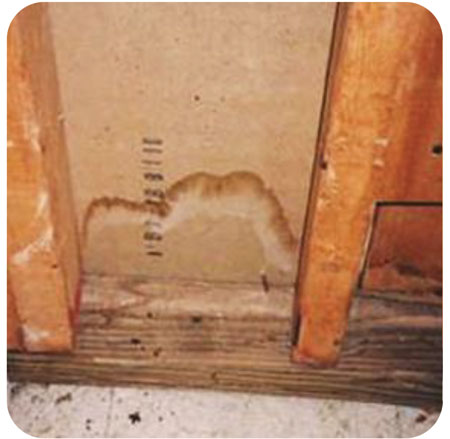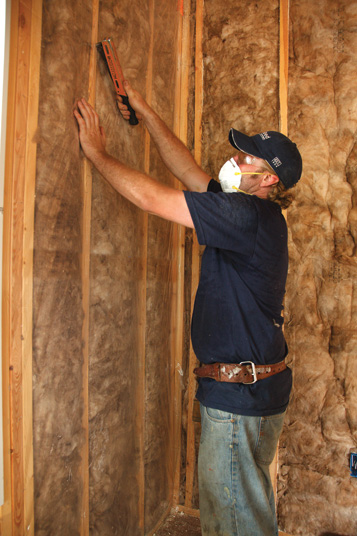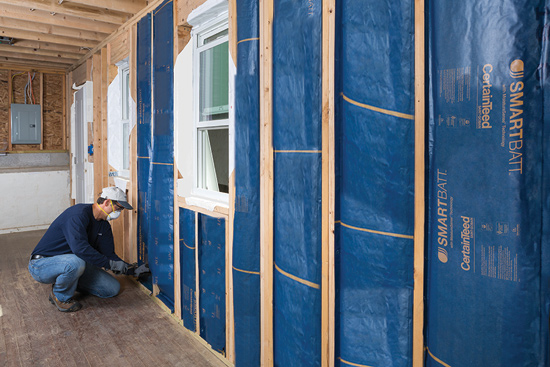The Science Behind Building Envelope Design in Framed Wall Assemblies
Moisture Movement
Water is not only among the most abundant substances on earth, it is one of the few that we experience regularly in three forms—as a liquid (water), a solid (ice), or a gas (vapor). While all three forms can have an impact on buildings, it is airborne water vapor, also called moisture, which can be the most troubling. The amount of moisture in the air for a given location is measured in terms of the relative humidity (RH) of the air. It is usually expressed as a percentage of the amount of moisture that is in the air compared to the maximum amount that the air can hold at its current temperature. Fundamentally, warm air can hold a higher maximum amount of moisture than cold air meaning that the RH can change as the temperature changes, even though the moisture content remains the same. So a body of air that has a fixed amount of moisture in it will see its RH fall as the temperature rises since its capacity to hold more moisture increases with the temperature rise. Similarly, RH will increase as the temperature falls.
There is a point, however, where the temperature and RH will coincide to allow for the airborne vapor to cool and condense into liquid form. We know this as the dew point and can observe it in action on a chilled drink container on a hot summer day. In a concealed wall system, we may not be able to observe it, but the same condensation will occur if the dew point is reached inside that wall. How does that happen? First, moisture has to penetrate into the wall assembly. Since the movement of moisture is directly related to the movement of the air which it inhabits, that means that any openings in the wall assembly that allow air to move into it, allow the moisture in that air to move into it too. Further, since warm air will want to move toward cool air, the temperature of the air will influence the rate and direction of air flow. The vapor in the air could also directly penetrate the surface material of the wall in a process known as diffusion. Materials are rated on their ability to allow or prevent this diffusion by a permeability rating or perm rate. However the moisture enters a wall system, the combination of RH and temperature need to combine to create a dew point condition which will then cause condensation to occur.
Climate Variations
The eight different climate zones noted earlier each have their own characteristics and implications as they relate to building science. The zones are based on the 45-year average number of annual degree-days. A degree day is determined by calculating the number of days that a location is above or below a baseline temperature (65°F in this case) times the number of degrees that it is above or below that base. They are separated into heating and cooling degree-days to indicate how hot or cold a location is relative to the base on an annualized basis. The differences in zones reveals the variations in heating and cooling requirements that exist in different parts of the country. The significance is that heat flow, air pressure, and moisture movement are all affected by differences in climate since they are all affected by differences in temperature and other factors represented in those climates. Places that experience colder temperatures with lower relative humidity will have different patterns of heat, air, and moisture flow than places that are warmer and more humid. Hence, climate differences are a significant and relevant factor in understanding the building science of framed walls.

Image courtesy of CertainTeed Insulation
Heat, air pressure, and humidity all seek equilibrium between inside and outside of a building. The direction of flow is directly influenced by the building location (climate zone) and the temperature conditions experienced.
Design and Construction Considerations
The prior discussion illustrates why the successful design of a properly performing framed wall is directly related to properly applying the relevant building science. Informed by an understanding of these principles, materials can be selected and wall assemblies designed that use the building science as an advantage for performance rather than a set of obstacles to overcome. Following are some design approaches and considerations to incorporate building science into framed wall assemblies:
Design for Thermal Control
Fundamentally, maintaining the building interior at a different temperature than the outdoor environment sets up a system of causes and effects. Heat will seek to flow from the warm side to the cool side which of course will vary by location (climate zone) and time of year. But it can also vary by time of day and local weather conditions. Hence, no wall is commonly only trying to restrict heat flow in one direction, but usually in both at different times. The best and most common way to reduce heat flow is to use building insulation between the framing members. Recognizing that those framing members interrupt the insulation and can be a contributor to thermal bridging, continuous insulation across the inside or outside of the framing is also becoming more common and even required by code in certain climate zones. This can be accomplished using rigid or spray foam insulation or other types of board insulation intended for this purpose.
Design for Air Flow Control
The use of materials that provide an air barrier is the first line of defense on both the inside and outside of wall assemblies. Building codes require an air and water barrier be located behind the finish or cladding on the outside to prevent any air and water from penetrating there. This can be accomplished with a sheathing or other material that has been certified as an air and or water barrier or through the use of an add-on material such as a building wrap. Either way, sealing the seams and connections are as important as the material itself. On the inside, solid materials will prevent air flow but so will vapor barriers that are required by energy codes. The prevention of air flow will not only inhibit heated air transfer in the wall, but also moisture transfer from vapor. For that reason, it is important to pay attention to gaps, breaks, and openings not only in the barrier materials of the wall assembly, but of the framing too. Sealing around all framing joints and openings will stop air from entering the cavities particularly if a first line barrier should fail or become compromised. The cavities in the framing system can also be prime ground for convection currents of air to be created within it. A warm surface temperature on one side of the wall will cause air within the cavity to heat and rise while cooler, denser air on the other side will fall, setting up an unintended short circuit of heat transfer. Using an insulation material that does not let air pass through it will help prevent this from happening. Beyond material selection and wall design, attention to detail will help minimize openings wherever possible so the materials of the wall assembly aren't breached to begin with and allow air flow.
Design for Moisture and Water Control
While it would be good to assume that moisture and water can be perfectly sealed out of wall assemblies, the reality is that wall construction is not based on perfection but on reasonable good quality. Hence, it is more prudent to assume that some moisture intrusion and migration will likely occur within a framed wall and plan for it to escape accordingly. Failure to do so could lead to condensation and accumulation which will rest on wood and metal framing, potentially causing deterioration and damage not only to the wall but to the building.
It is worth pointing out that computer simulation or energy modeling is commonly used to look at the performance of a wall assembly in one or more climate conditions. This is very useful and can help identify locations in the wall where dew points can occur in different situations that could lead to condensation and water build up. However, moisture accumulation due to air flow into the wall is more difficult to model since the number of variables are excessive. Hence, such computer modeling can help inform the design of a wall system for heat transfer, mass, and other quantifiable items, but should not be expected to predict moisture and water accumulation.

Photo courtesy of CertainTeed Insulation
Moisture that condenses in framed wall assemblies or leaks in from the outside is the leading cause of material damage and, if conditions are right, can promote the growth of mold.
In practice, moisture problems account for up to 80 percent of damage in building envelopes. Beyond air flow, moisture problems can occur if materials are used that are moisture-sensitive (i.e. absorb and retain moisture or water with a loss in performance), or if older systems and components are in use that are not designed to resist any moisture. In cases where wetting and drying are either anticipated or allowed, problems can still exist when the rate of wetting exceeds the rate of drying, creating an ongoing wet or moist condition.
With the above in mind, a common consequence of not allowing water and moisture to leave a wall assembly is the creation of mold. Mold is a naturally occurring organism which requires three things to grow—moisture, temperatures that are favorable (moderately warm), and a food source, meaning some organic material. In a framed wall assembly, moisture laden air or direct water penetration that settle in an insulated area of a moderate temperature provide the ideal setting. If the moisture is in contact with organic materials such as some insulation, wood framing, or wood based sheathing then mold can grow. If any of the three ingredients are eliminated, then mold will not grow. Eliminate more than one and the chances are even better that problems resulting from mold growth can be controlled or eliminated.
Why worry about mold? Numerous sources have linked it to significant health effects in people such as illnesses like asthma and other respiratory disorders, which have an obvious impact on productivity and well-being regardless of the building type or location. Signs that mold may exist in a wall include rotting of wood studs and exterior trim, efflorescence, spalling, and discoloration of material. Some signs can be temporary, such as observed water leakage after a rain storm, or icicle formation during cold periods. What matters is that the design of the wall must minimize moisture entry and maximize exit so that no component stays too wet for too long. What makes it a bit more insidious is that hidden mold may exist even if physical signs are not readily visible. If water damage exists in a building or if occupants are reporting odors or health problems, then there is good cause to suspect mold is hidden in an assembly somewhere. The common places to check for mold growth include behind wallpaper, paneling, or furniture; around plumbing pipes, in drywall, or above ceiling tiles; inside ductwork or roof materials; any other place that moisture, moderate temperatures, and organic materials are believed to be present.
So how do we design framed wall assemblies to overcome these issues? There are three general strategies to always incorporate. The first is to control wetting of materials from both inside and outside the building. On the exterior, water can be deflected or minimized by limiting rain exposure from overhangs, eaves, or other protective measures. On the inside, framed wall assemblies need to be protected as much as possible from air transport and vapor diffusion through the use of vapor barriers, air barriers, control of air pressure, and mechanical controls for ventilation and humidity. The second strategy is to provide a means for any moisture that does enter the wall assembly to drain away. The means to do this will vary depending on the wall assembly type. The third strategy is to use components or materials that allow any moisture to be repelled or escape, thus drying the materials and preventing any impact on performance.


Photos courtesy of CertainTeed Insulation
Installation of vapor barriers is required by building codes because they are critically important for keeping moisture out of exterior framed wall assemblies.
Of course specific strategies will depend on climate conditions. In cold climates, vapor and air barriers need to be located toward the interior of the assembly since most heat and air flow will be driven from inside to outside. The exterior will still need an air and water barrier for weather and wind driven conditions. If low permeance exterior sheathings are used, they will require temperature control on the outer, cooler, surfaces where condensation can occur. In mixed climates, permeable building materials on both the interior and exterior surfaces allow water vapor to flow-through suggesting that air barriers are needed that limit movement in both directions. Insulating sheathing or external continuous insulation can help control the temperature of surfaces where condensation may occur. In hot and humid climates, vapor barriers need to be located at the exterior of building assemblies to keep moisture and air from flowing from the warmer, moister outside to the presumably cooler and drier air conditioned inside. Air barriers are still needed in the wall assembly and dehumidification of the interior air not only helps with human comfort but with building longevity as well. In these predominantly hot, humid locations, specific measures such as insulating cold water piping and cold duct distribution systems can help avoid condensation in walls. And in these locations, drying should be directed toward the interior where the moisture will be treated, not the exterior where it may cause further infiltration.









